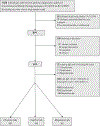Comparative effectiveness of omalizumab, mepolizumab, and dupilumab in asthma: A target trial emulation
- PMID: 36740144
- PMCID: PMC10164684
- DOI: 10.1016/j.jaci.2023.01.020
Comparative effectiveness of omalizumab, mepolizumab, and dupilumab in asthma: A target trial emulation
Abstract
Background: Multiple mAbs are currently approved for the treatment of asthma. However, there is limited evidence on their comparative effectiveness.
Objective: Our aim was to compare the effectiveness of omalizumab, mepolizumab, and dupilumab in individuals with moderate-to-severe asthma.
Methods: We emulated a hypothetical randomized trial using electronic health records from a large US-based academic health care system. Participants aged 18 years or older with baseline IgE levels between 30 and 700 IU/mL and peripheral eosinophil counts of at least 150 cells/μL were eligible for study inclusion. The study period extended from March 2016 to August 2021. Outcomes included the incidence of asthma-related exacerbations and change in baseline FEV1 value over 12 months of follow-up.
Results: In all, 68 individuals receiving dupilumab, 68 receiving omalizumab, and 65 receiving mepolizumab met the inclusion criteria. Over 12 months of follow-up, 31 exacerbations occurred over 68 person years (0.46 exacerbations per person year) in the dupilumab group, 63 over 68 person years (0.93 per person year) in the omalizumab group, and 86 over 65 person years (1.32 per person year) in the mepolizumab group (adjusted incidence rate ratios: dupilumab vs mepolizumab, 0.28 [95% CI = 0.09-0.84]; dupilumab vs omalizumab, 0.36 [95% CI = 0.12-1.09]; and omalizumab vs mepolizumab, 0.78 [95% CI = 0.32-1.91]). The differences in the change in FEV1 comparing patients who received the different biologics were as follows: 0.11 L (95% CI = -0.003 to 0.222 L) for dupilumab versus mepolizumab, 0.082 L (95% CI -0.040 to 0.204 L) for dupilumab versus omalizumab, and 0.026 L (95% CI -0.083 to 0.140 L) for omalizumab versus mepolizumab.
Conclusions: Among patients with asthma and eosinophil counts of at least 150 cells/μL and IgE levels of 30 to 700 kU/L, dupilumab was associated with greater improvements in exacerbation and FEV1 value than omalizumab and mepolizumab.
Keywords: Asthma; allergic; comparative effectiveness; dupilumab; eosinophilic; mAbs; mepolizumab; omalizumab; target trial emulation.
Copyright © 2023 The Authors. Published by Elsevier Inc. All rights reserved.
Figures
References
-
- Drazen JM, Harrington D. New Biologics for Asthma. N Engl J Med. 2018;378(26):2533–4. - PubMed
-
- Brusselle GG, Koppelman GH. Biologic Therapies for Severe Asthma. N Engl J Med. 2022;386(2):157–71. - PubMed
-
- Fajt ML, Wenzel SE. Asthma phenotypes and the use of biologic medications in asthma and allergic disease: the next steps toward personalized care. The Journal of allergy and clinical immunology. 2015;135(2):299–310; quiz 1. - PubMed
Publication types
MeSH terms
Substances
Grants and funding
LinkOut - more resources
Full Text Sources
Medical
Miscellaneous




